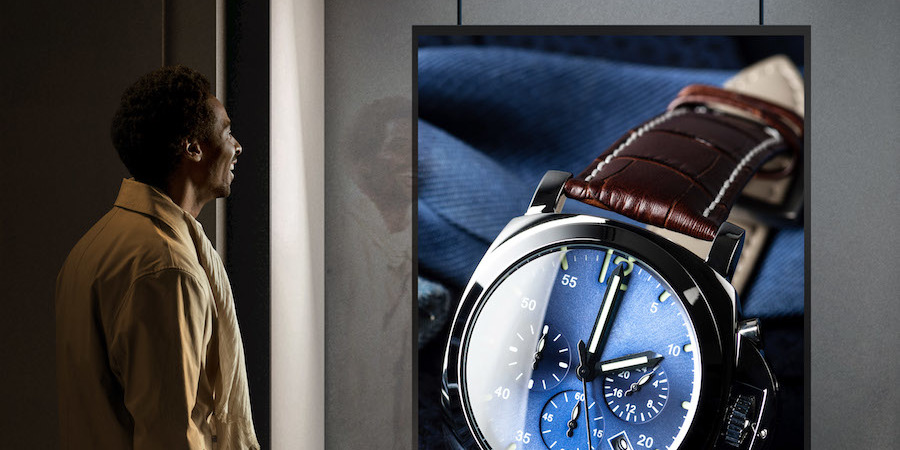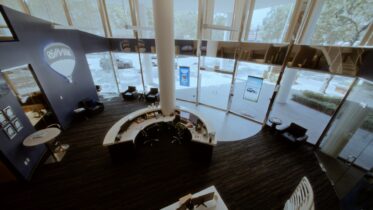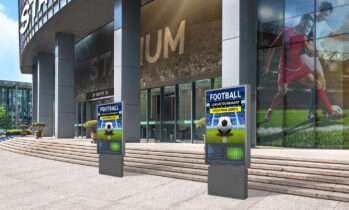Storefront displays are the first visuals potential shoppers will see that can engage their senses and lure them inside to browse.
Retail digital signage in store aisles and at display kiosks is an effective marketing and merchandising tool for driving sales and educating shoppers, but there’s also a big role for digital displays in storefront windows.
One of the ways to boost sales, after all, is getting more consumers to come through shop doors.
Welcoming Shoppers
Retail digital signage aimed at passersby can be particularly effective for sales promotions, product and service launches, customer notices and branding. Shop windows may do nothing more exotic than let people know which select items are on sale today. Or, a sophisticated cluster of displays could be tied to data from external systems, showing dynamic, frequently changing pricing on anything from last-minute vacations to concert and attractions tickets.
Some fashion retailers are using digital signage as the main marketing statements for their newest lines, with screens filling windows with visuals from model shoots and the New York, Milan and Paris runways.
Digital Transformation Solutions for Retail
Register to learn how to unify an omnichannel marketing strategy from the storefront to the point of sale in this webinar. Download Now
Meanwhile, real estate companies are replacing paper sheets and posters with digital screens in their windows to more dynamically showcase available listed properties. By going digital, agents can market as many properties as they want, adding more visuals in ways not possible in the same physical space with print. They can also promote and remove listings at a moment’s notice.
Food services operators — from quick service restaurants to more formal dining establishments — are using outside-facing screens to show menus, highlight special offers and give consumers a better sense of the dining experience within.
Ensuring Success
The benefits are well-established, but that doesn’t mean outside-facing digital signage is a simple project with guaranteed returns. Success depends on having objectives and measurable returns, an effective content plan and — most of all — the right technology.
Not just any new screen will be appropriate for window placement. The signage on shop walls and fixtures is probably not appropriate for windows — and definitely not for outside. Regular, indoor-rated signage is simply not designed to handle natural sunlight beaming on it for many hours each day. The visuals will typically become washed out and pale as they lose the battle with midday glare.
They’ll also be baking from the heat load of direct sunlight. Overheated electronics fail, and screens, if they keep working, may degrade quickly.
That’s why display manufacturers like Samsung have developed high-brightness, window-facing displays with the lighting power to overcome glare, and the environmental engineering to handle both heat and cold.
For example, Samsung’s OMN Series displays features 4,000 nits brightness, for impact on even the brightest days, and come with autobrightness controls that sense ambient lighting conditions, only using as much lighting power as needed at any given time. In the evening, the built-in sensor reduces the brightness to the level of mainstream displays, and raises it up the next morning when the sun returns. The OMN-D series, meanwhile, are dual-sided displays to attract customers then entice them once in your store. Exterior/interior brightness is 3,000 nits/1,000 nits in the OMN-D series.
The engineering even factors in the impact of sunglasses on viewing quality. Polarized sunglasses tend to distort what wearers see on conventional digital signage LCD screens, but properly engineered high-brightness screens include technology that counteracts the distortion and deals with what is sometimes called display blindness.
Assessing Impact
With the right screen selections made, retailers placing screens in windows can focus on the objectives for the screen or screens, and measure whether what’s in place is working. The simplest way to assess impact is measuring what happened before the screens went in, and after. This “pre and post” assessment will tell operators if the new screens affected tangible counts like store foot traffic, overall sales or sales on items promoted by the screens.
Another way to assess impact, for retailers with multiple locations, is to install screens in a selection of stores and compare what happens against a set of “control” stores with similar historical sales and customer numbers. The control element is important, as the assessment should rule out variables.
Performance will also be affected by what’s on the screen. Good signage is based on good content, and simply swapping a poster for a screen won’t be enough to catch — let alone capture — viewers’ attention.
Effective in-window retail digital signage content is based on simplicity, relevance and action steps. People are walking or even driving past windows, so the message needs to be viewed and absorbed in three to five seconds. That demands minimalist design, just as billboards do.
The message should be relevant to the time and place. That means, for example, having a rain boots message when it’s wet outside, and not when it’s nothing but blue skies.
Use messaging that stimulates a reaction — something as simple as “Come in Now for Free Samples!” Don’t make people think about how to react. Tell them!
Signs in shop windows have been around as long as shops, and the basic strategies haven’t changed much since. What’s different now, with retail digital signage, is the opportunity to take advantage of the stopping power of bright displays and stunning, motion visuals, and the flexibility to change messages on demand.
Take your digital signage strategy beyond the first contact to enhance the buyer’s journey. Then see how other major retailers are stepping up their display game from the outside in.








